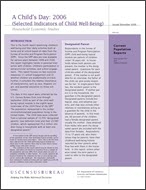
An official website of the United States government
Here’s how you know
Official websites use .gov
A .gov website belongs to an official government organization in the United States.
Secure .gov websites use HTTPS
A lock (
) or https:// means you’ve safely connected to the .gov website. Share sensitive information only on official, secure websites.
-
//
- Census.gov /
- Publications /
- A Child's Day: 2006 (Selected Indicators of Child Well-Being)
A Child's Day: 2006 (Selected Indicators of Child Well-Being)
A Child's Day: 2006 (Selected Indicators of Child Well-Being)
Introduction
This is the fourth report examining children’s well-being and their daily activities both at home and at school based on data from the Survey of Income and Program Participation (SIPP). Since the SIPP data are now available for various years between 1998 and 2006, this report highlights trends in parental interaction with children, children’s participation in extracurricular activities, and school engagement. This report focuses on two outcome measures: (1) school engagement and (2) whether children are academically on-track. Further, it considers the relative importance of characteristics such as race, Hispanic origin, and parental education on those outcomes.
The data in this report were collected by the U.S. Census Bureau from June through September 2006 as part of the child well-being topical module in the eighth wave (interview) of the 2004 Panel of the SIPP.1 The population represented is the civilian noninstitutionalized population living in the United States. The 2006 data were collected from a national sample of 12,755 “designated parents” (see definition box) and their 23,587 children, which represented 73.2 million children living in households with at least one designated parent.2
_______________
1 A description of the SIPP survey design and the wording of the questions on the child well-being topical module can be found at <www.census.gov/sipp/>. Since, this is the first time data collection for the child well-being topical module has taken place in the summer, there may be some minor comparability issues with prior surveys.
2 The estimates in this report (which may be shown in text, figures, and tables) are based on responses from a sample of the population and may differ from actual values because of sampling variability or other factors. As a result, apparent differences between the estimates for two or more groups may not be statistically significant. All comparative statements have undergone statistical testing and are significant at the 90 percent confidence level unless otherwise noted.
Others in Series
Publication
Publication
Publication
Share
Some content on this site is available in several different electronic formats. Some of the files may require a plug-in or additional software to view.
 Yes
Yes
 No
NoComments or suggestions?


Top

